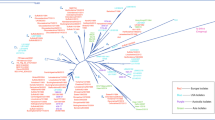Abstract
Equine pegivirus (EPgV) is a newly discovered equine virus, which is taxonomically classified in the Pegivirus genus of the Flaviviridae family. Until now, only the complete genome sequence of the first reported EPgV strain, from the USA (strain name: C0035) is available on online databases. Considering this, horse serum samples were collected from horses in China and screened for EPgV RNA by RT-PCR. One EPgV strain, LW/2016, was obtained and its near-complete genome sequence was acquired by standard PCR. Further analysis of its nucleotide sequence indicates LW/2016 is genetically divergent from C0035, with a nucleotide identity of 89.02%. These two viruses clustered into two independent branches following phylogenetic analysis of on the NS3 and NS5B genes. To our knowledge, this is the first report of genetic divergence in the EPgV genome.

Similar content being viewed by others
Change history
23 November 2017
Unfortunately, the corresponding author name was incorrectly published in the original article and the same is corrected here. The original article was corrected.
References
Smith DB, Becher P, Bukh J, Gould EA, Meyers G, Monath T, Muerhoff AS, Pletnev A, Rico-Hesse R, Stapleton JT, Simmonds P (2016) Proposed update to the taxonomy of the genera Hepacivirus and Pegivirus within the Flaviviridae family. J Gen Virol 97(11):2894–2907. doi:10.1099/jgv.0.000612
Pfaender S, Brown RJ, Pietschmann T, Steinmann E (2014) Natural reservoirs for homologs of hepatitis C virus. Emerg Microbes Infect 3(3):e21. doi:10.1038/emi.2014.19
Adams MJ, Lefkowitz EJ, King AMQ, Harrach B, Harrison RL, Knowles NJ, Kropinski AM, Krupovic M, Kuhn JH, Mushegian AR, Nibert M, Sabanadzovic S, Sanfacon H, Siddell SG, Simmonds P, Varsani A, Zerbini FM, Gorbalenya AE, Davison AJ (2017) Changes to taxonomy and the International Code of Virus Classification and Nomenclature ratified by the International Committee on Taxonomy of Viruses (2017). Arch Virol 162(8):2505–2538. doi:10.1007/s00705-017-3358-5
Kapoor A, Simmonds P, Cullen JM, Scheel TK, Medina JL, Giannitti F, Nishiuchi E, Brock KV, Burbelo PD, Rice CM, Lipkin WI (2013) Identification of a pegivirus (GB virus-like virus) that infects horses. J Virol 87(12):7185–7190. doi:10.1128/JVI.00324-13
Lyons S, Kapoor A, Schneider BS, Wolfe ND, Culshaw G, Corcoran B, Durham AE, Burden F, McGorum BC, Simmonds P (2014) Viraemic frequencies and seroprevalence of non-primate hepacivirus and equine pegiviruses in horses and other mammalian species. J Gen Virol 95(Pt 8):1701–1711. doi:10.1099/vir.0.065094-0
de Souza AJ, Malheiros AP, de Sousa ER, Moreira AC, Silva AL, das Chagas AA, Freitas PE, Gemaque BS, de Figueiredo HF, de Sa LR, dos Santos PD, Soares MC (2015) First report of equine Pegivirus in South America, Brazil. Acta Trop 152:56–59. doi:10.1016/j.actatropica.2015.08.014
Postel A, Cavalleri JM, Pfaender S, Walter S, Steinmann E, Fischer N, Feige K, Haas L, Becher P (2016) Frequent presence of hepaci and pegiviruses in commercial equine serum pools. Vet Microbiol 182:8–14. doi:10.1016/j.vetmic.2015.10.032
Lu G, Sun L, Xu T, He D, Wang Z, Ou S, Jia K, Yuan L, Li S (2016) First description of hepacivirus and pegivirus infection in domestic horses in China: a study in Guangdong Province, Heilongjiang Province and Hong Kong District. PLoS One 11(5):e0155662. doi:10.1371/journal.pone.0155662
Ross-Thriepland D, Harris M (2015) Hepatitis C virus NS5A: enigmatic but still promiscuous 10 years on! J Gen Virol 96(Pt 4):727–738. doi:10.1099/jgv.0.000009
Simmonds P (2004) Genetic diversity and evolution of hepatitis C virus—15 years on. J Gen Virol 85(Pt 11):3173–3188. doi:10.1099/vir.0.80401-0
Author information
Authors and Affiliations
Corresponding author
Ethics declarations
Funding
This work was supported by The National Natural Science Foundation of China (31402259), The Special Fund for Agro-scientific Research in the Public Interest (201303042), The National Key Research and Development Program of China (2016YFD0501004, 2016YFD0501010), The Promote Scientific and Technological Development Program (2013B040200032), The Guangdong Provincial Key Laboratory of Prevention and Control for Severe Clinical Animal Diseases (2013A061401013).
Conflict of interest
The authors declare no conflict of interest.
Ethical approval
No studies involving human participants or animals performed by any authors are described in this article.
Additional information
Handling Editor: Zhenhai Chen.
The original version of this article was revised: The corresponding author name was incorrectly published in the original article and the same is corrected here.
A correction to this article is available online at https://doi.org/10.1007/s00705-017-3654-0.
Electronic supplementary material
Below is the link to the electronic supplementary material.
Rights and permissions
About this article
Cite this article
Lu, G., Fu, C., Huang, J. et al. Molecular characterization of a genetically divergent equine pegivirus strain identified in China. Arch Virol 163, 249–252 (2018). https://doi.org/10.1007/s00705-017-3602-z
Received:
Accepted:
Published:
Issue Date:
DOI: https://doi.org/10.1007/s00705-017-3602-z




